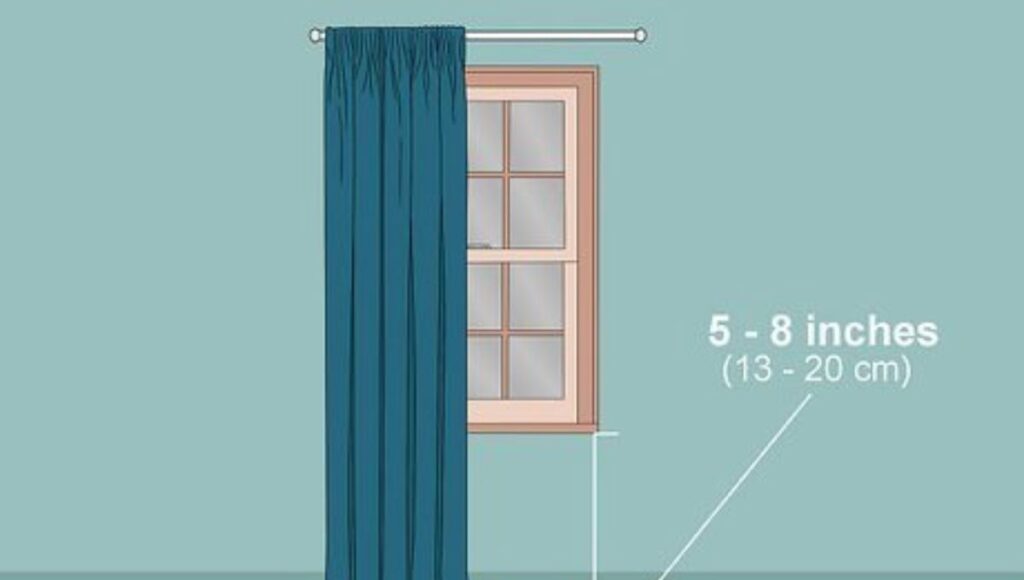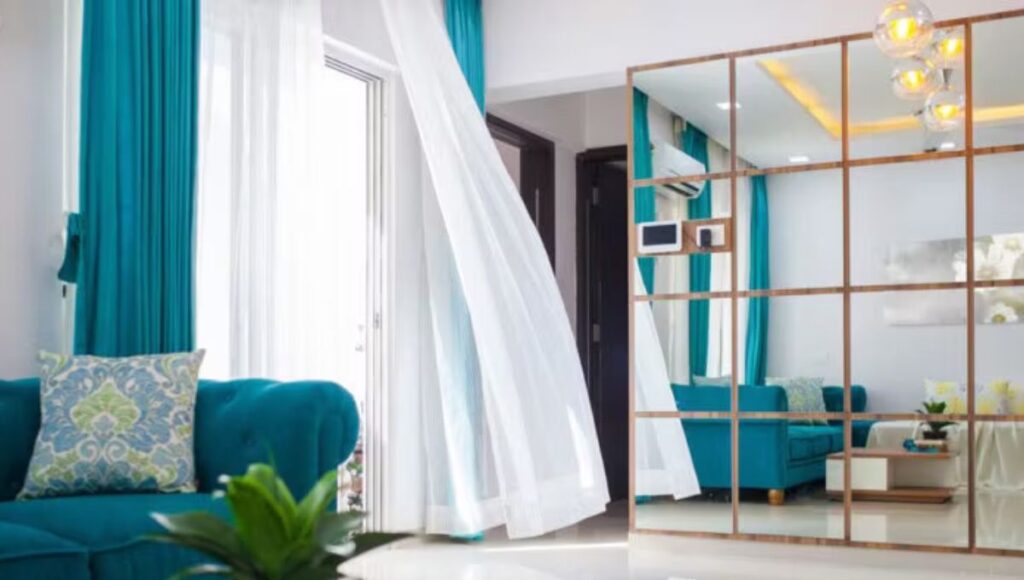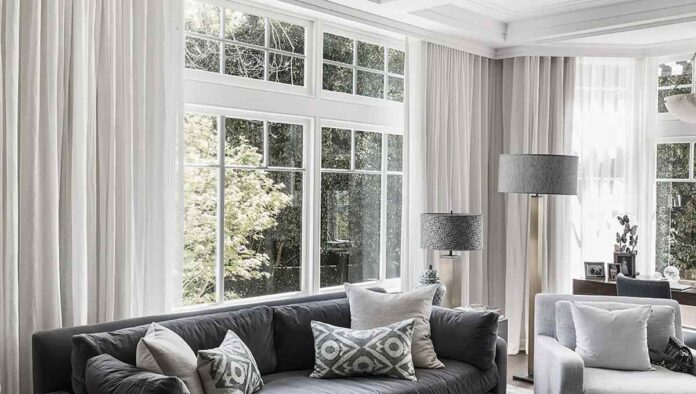Choosing the right curtains can totally change how your living room feels. If you want a cozy vibe, go for long, dark curtains. But if you prefer a bright and airy feel, opt for soft, sheer curtains or ones made from linen. Not sure where to start? Don’t worry! We’ll walk you through everything you need to think about when picking out curtains for your living room.
How To Choose Curtains For Living Room
Before you choose your living room curtains, think about what you want them to do. Do you need them to block out light or give you privacy? If that’s the case, focus on finding curtains that can do that job well. But if you’re just looking for curtains to add style to your room, then you have a lot more choices to consider.
- If you want privacy, go for living room curtains that fully cover your windows. Another option is to use blinds or shades underneath your curtains. This way, you can pick curtains based on how they look, without worrying too much about privacy.
- To control light, you’ll need a thick fabric.
- Sheers will still let in plenty of natural light while blocking out harsh direct sun.
- Medium-weight fabrics like linens will let some light filter through, but less than sheers.
- Thicker materials with a lining will block sunlight. You can also choose blackout curtains, which have a special lining to keep all the sunlight out.
Other factors in choosing drapes
- Think about all your windows together. If you want your room to look put together, make sure all the curtains hang at the same height and are the same length.
- Windows can be different heights, even if they look similar. Even a small difference matters, so measure each window carefully. Also, measure how far each window is from the ceiling. Use the height of the window closest to the ceiling as a reference when installing the curtain rods for all the windows.
- To find the size of each window, measure from the top of the window frame to the bottom sill for the height. For the width, measure from the outer edge of one frame to the outer edge of the other.
How To Measure Curtains

When it comes time to measure the curtains, you’ll have a few decisions to make:
When it comes to curtains, you have two main options: custom or standard sizes. Custom curtains offer lots of choices, like where to hang them, how wide they should be, and their overall length. Plus, you can get help from a pro if you need it. But if you go for standard sizes, you’ll have to stick to the basic lengths and widths available.
How long do the drapes need to be?
If you want floor-length living room curtains, you’ll need to choose how you want them to hang. Standard curtain panel lengths come in various sizes: 63 inches, 84 inches, 95 inches, 108 inches, and 120 inches. But remember, the height of your window and where you mount the rod might limit how the curtains hang.
- Brushing the floor – These curtains will hang just above the floor by about half an inch.
- Breaking the floor – Curtains hung this way will touch the floor and have a slight bend at the bottom, but they won’t create a puddle. Usually, they’re about 1 to 3 inches longer than the floor measurement.
- Pooling on the floor – Drapes that hang like this are longer, about 6 to 12 inches past the floor measurement. They’ll create a nice puddle effect at the bottom.
How wide do you want the drapes to be?
First, decide if you want the curtains to completely cover the window. If you’re using curtains with blinds or if they’re just for looks, you don’t have to be super exact. But if you do want full coverage, you’ll need to do some extra math.
- When measuring the width, add 12 inches to each side to ensure it covers the molding and leaves enough space for the rod. The rod should extend 4 to 6 inches beyond each side of the window frame.
- Typical ready-made curtain panels are usually 48 inches wide. However, they might be narrower if they have pleats or gathers.
- Some sheers come in double widths.
Should Curtains Touch The Floor?

Floor-length curtains are the way to go for a stylish look. Shorter curtains can make your space look old-fashioned. If you can’t have long curtains, it’s better to stick with just blinds or shades.
When living room curtains reach the floor, they give the room a taller and more elegant appearance. There are three ways to achieve this: curtains that hang half an inch above the floor, curtains that just touch the floor, and curtains that create a puddle with 6-12 inches of extra fabric.
Which Curtain Is Best For The Living Room?
The right living room curtains depend on your home’s style and what you can afford. Since this is a room where everyone gathers, choose the highest quality curtains you can, whether they’re custom-made or ready-made.
- Choose long drapes for the living room – always.
- Pick a style – pleated, grommet, pole pocket – that fits the level of formality in the room.
- Choose the fabric based on what you need for privacy and light control, but aside from that, pick the type you personally prefer.
- Living room curtains can be simple and neutral or have vibrant patterns. Just remember to consider the existing patterns and colors in the room. Also, if there are many windows, the curtain colors or patterns will stand out a lot.
Are Living Room Curtains Outdated?
In some homes, living room drapes are less common, especially for those aiming for a modern or minimalist style. However, they’ll never completely go out of style.
Instead of thinking of curtains as old-fashioned, it’s better to focus on the styles that are popular and suitable for today’s homes. Some types of window treatments, like café-length curtains, valances, and overly ruffled styles, have become less popular.
Once you’ve considered functionality, the appearance and vibe of living room curtains become crucial. Even in minimalist spaces, the right style of curtains can make a difference. Whether it’s neutral sheers or Japanese-style panels, there are plenty of curtain types that are suitable additions to modern living rooms.
how to choose the best curtain fabrics

Choosing the right curtain fabric depends on what you need, your personal style, and the atmosphere you want to create. Consider how much light you want to allow in—thicker fabric will block light better than sheer fabric. Keep reading to discover the most popular types of curtains and find the perfect one for your home.
SILK CURTAINS
Silk curtains are a timeless choice for dressing up your windows, adding a touch of elegance to your space. They look extra luxurious when they’re pleated or slightly pooled on the floor. Adding a lining to your silk curtains is essential for extra privacy, especially since silk or sheer silk fabrics can be somewhat see-through.
COTTON CURTAINS
Cotton curtains are a practical choice for windows because they’re versatile and easy to maintain. They can go from casual to formal effortlessly. You can find them in various colors and styles. Cotton or cotton-linen curtains are a bit sturdier compared to other fabrics, providing good privacy. If you want to add a touch of luxury and modern flair, consider cotton velvet curtains, which bring a rich texture to any space.
LINEN CURTAINS
Linen curtains, particularly those made from cotton linen, are commonly found in relaxed settings. Their lightweight and sheer nature adds a breezy feel to the room and allows more light to filter through compared to other fabrics. If you’re looking for blackout curtains, EUROPEAN FLAX®-Certified Linen is a great choice due to its thick fabric that effectively blocks unwanted outdoor light.
VELVET CURTAINS
Velvet curtains are a lavish option for dressing up your windows. Their heavyweight fabric adds a luxurious feel to your bedroom or living room. While it’s not required, adding liners can boost the formal look of velvet curtains, especially when they’re pulled open.
SHEER CURTAINS
If you enjoy having lots of natural light in your living room, sheer curtain panels are perfect for keeping the space bright. Similar to silk, sheer material is see-through, so if you want more privacy, you’ll need liners. Another option is to go for semi-sheer curtains, which strike a nice balance between letting light in and providing privacy.
how to choose curtains for every room

When picking curtains for your living room or bedroom, it’s important to consider how you’ll use them. Think about the level of privacy you need and how much light you want in the room. Keep reading to discover how to choose the perfect curtains for every space, from the living room to the dining room.
LIVING ROOM CURTAINS
When selecting curtains for your family room, think about how you’ll use them and the level of privacy you need. Consider how much sunlight you want to let in through the windows. We suggest using sheer curtains to create a bright atmosphere when spending time with family or entertaining guests. Alternatively, you can choose heavier fabrics like blackout curtains to regulate the amount of light coming into the room.
BEDROOM CURTAINS
Bedroom curtains are a great choice for taking an afternoon nap or relaxing in private. If you prefer your bedroom to be dark, go for curtains made from heavier fabrics or opt for blackout curtains. Heavier materials like velvet or silk curtains can add a luxurious touch to your bedroom.
DINING ROOM CURTAINS
Bring some character to your dining room by selecting a playful printed curtain or incorporating a neutral cotton linen curtain. Pick dining room curtains that match your hosting style and contribute to the atmosphere of the space.
How to Choose Curtain Colour

Choosing the right curtain color for your home is important. Ideally, your curtain designs should match or complement the rest of your furnishings. You can choose curtains that blend in with the decor or ones that stand out. To create a pleasing look, pick curtains that match the color of your walls. If you want the curtains to be a focal point, choose a color that contrasts with your furniture and walls.
Living room side table decoration ideas
Select the Ideal Length of Curtains for Windows and Doors

When selecting curtains for your living room or bedroom, pay attention to the length. Curtains that reach the floor are trendy. For a more dramatic effect, you can choose curtains that are slightly longer so they puddle on the floor. However, if you have kids, it’s wise to hang curtains a couple of inches above the floor. Another classic option is to end curtains at the sill, but full-length drapes can also look great.
Measure the Width of Your Curtain for Windows and Doors

When choosing curtains for your home, consider the width as well. The right width depends on the width of your window or door frame. A good rule is to measure the frame and multiply it by 2 or 2.5. This extra fabric creates a gathered look on the sides when you draw the curtains back.
Select Fabrics Based on the Maintenance Required

The type of fabric and material used for curtains determines how they should be cleaned and how often. Generally, curtains should be washed every three to six months. However, some fabrics need more delicate care, while others can be machine-washed.
- Low-maintenance fabrics: If you want curtains that require washing twice a year, choose cotton or synthetic fabrics. These can be machine-washed if they’re unlined. For lined curtains, give them a quick hand wash. These curtains are a good choice for people with dust allergies or homes with kids and pets.
- High-maintenance fabrics: Curtains with pleats or swags should always be dry-cleaned, regardless of the fabric. For wool, silk, and sheer curtains, it’s best to dry-clean them or hand-wash them in cold water to keep their color and shape intact.
If you have dust allergies, consider vacuuming your drapes and curtains weekly to help reduce dust buildup.


[…] How To Choose Curtains For Living Room […]